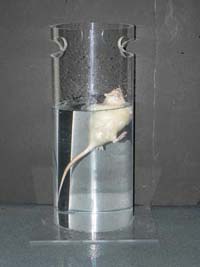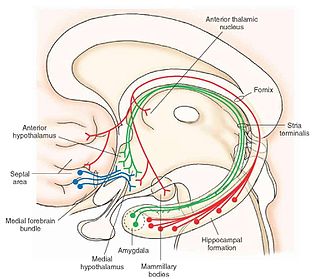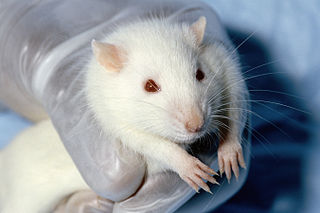Related Research Articles

Maprotiline, sold under the brand name Ludiomil among others, is a tetracyclic antidepressant (TeCA) that is used in the treatment of depression. It may alternatively be classified as a tricyclic antidepressant (TCA), specifically a secondary amine. In terms of its chemistry and pharmacology, maprotiline is closely related to such-other secondary-amine TCAs as nortriptyline and protriptyline and has similar effects to them, albeit with more distinct anxiolytic effects. Additionally, whereas protriptyline tends to be somewhat more stimulating and in any case is distinctly more-or-less non-sedating, mild degrees of sedation may be experienced with maprotiline.

5-HT receptors, 5-hydroxytryptamine receptors, or serotonin receptors, are a group of G protein-coupled receptor and ligand-gated ion channels found in the central and peripheral nervous systems. They mediate both excitatory and inhibitory neurotransmission. The serotonin receptors are activated by the neurotransmitter serotonin, which acts as their natural ligand.

The behavioural despair test is a test, centered on a rodent's response to the threat of drowning, whose result has been interpreted as measuring susceptibility to negative mood. It is commonly used to measure the effectiveness of antidepressants, although significant criticisms of its interpretation have been made.

The medial forebrain bundle (MFB) is a neural pathway containing fibers from the basal olfactory regions, the periamygdaloid region and the septal nuclei, as well as fibers from brainstem regions, including the ventral tegmental area and nigrostriatal pathway.
A serotonin–norepinephrine–dopamine reuptake inhibitor (SNDRI), also known as a triple reuptake inhibitor (TRI), is a type of drug that acts as a combined reuptake inhibitor of the monoamine neurotransmitters serotonin, norepinephrine, and dopamine. It does this by concomitantly inhibiting the serotonin transporter (SERT), norepinephrine transporter (NET), and dopamine transporter (DAT), respectively. Inhibition of the reuptake of these neurotransmitters increases their extracellular concentrations and, therefore, results in an increase in serotonergic, adrenergic, and dopaminergic neurotransmission. The naturally-occurring and potent SNDRI cocaine is widely used recreationally and often illegally for the euphoric effects it produces.

Tipepidine (INN), also known as tipepidine hibenzate (JAN), is a synthetic, non-opioid antitussive and expectorant of the thiambutene class. It acts as an inhibitor of G protein-coupled inwardly-rectifying potassium channels (GIRKs). The drug was discovered in the 1950s, and was developed in Japan in 1959. It is used as the hibenzate and citrate salts.

The serotonin 1A receptor is a subtype of serotonin receptors, or 5-HT receptors, that binds serotonin, also known as 5-HT, a neurotransmitter. 5-HT1A is expressed in the brain, spleen, and neonatal kidney. It is a G protein-coupled receptor (GPCR), coupled to the Gi protein, and its activation in the brain mediates hyperpolarization and reduction of firing rate of the postsynaptic neuron. In humans, the serotonin 1A receptor is encoded by the HTR1A gene.

Antalarmin (CP-156,181) is a drug that acts as a CRH1 antagonist.

2-Methyl-6-(phenylethynyl)pyridine (MPEP) is a research drug which was one of the first compounds found to act as a selective antagonist for the metabotropic glutamate receptor subtype mGluR5. After being originally patented as a liquid crystal for LCDs, it was developed by the pharmaceutical company Novartis in the late 1990s. It was found to produce neuroprotective effects following acute brain injury in animal studies, although it was unclear whether these results were purely from mGluR5 blockade as it also acts as a weak NMDA antagonist, and as a positive allosteric modulator of another subtype mGlu4, and there is also evidence for a functional interaction between mGluR5 and NMDA receptors in the same populations of neurons. It was also shown to produce antidepressant and anxiolytic effects in animals, and to reduce the effects of morphine withdrawal, most likely due to direct interaction between mGluR5 and the μ-opioid receptor.

3-( ethynyl)pyridine (MTEP) is a research drug that was developed by Merck & Co. as a selective allosteric antagonist of the metabotropic glutamate receptor subtype mGluR5. Identified through structure-activity relationship studies on an older mGluR5 antagonist MPEP, MTEP has subsequently itself acted as a lead compound for newer and even more improved drugs.

Conditioned place preference (CPP) is a form of Pavlovian conditioning used to measure the motivational effects of objects or experiences. This motivation comes from the pleasurable aspect of the experience, so that the brain can be reminded of the context that surrounded the "encounter". By measuring the amount of time an animal spends in an area that has been associated with a stimulus, researchers can infer the animal's liking for the stimulus. This paradigm can also be used to measure conditioned place aversion with an identical procedure involving aversive stimuli instead. Both procedures usually involve mice or rats as subjects. This procedure can be used to measure extinction and reinstatement of the conditioned stimulus. Certain drugs are used in this paradigm to measure their reinforcing properties. Two different methods are used to choose the compartments to be conditioned, and these are biased vs. unbiased. The biased method allows the animal to explore the apparatus, and the compartment they least prefer is the one that the drug is administered in and the one they most prefer is the one where the vehicle is injected. This method allows the animal to choose the compartment they get the drug and vehicle. In comparison, the unbiased method does not allow the animal to choose what compartment they get the drug and vehicle in. Instead, the researcher chooses the compartments.

Talsupram is a selective norepinephrine reuptake inhibitor (NRI) which was investigated as an antidepressant in the 1960s and 1970s but was never marketed. Along with talopram, it is structurally related to the selective serotonin reuptake inhibitor (SSRI) citalopram.
Animal models of depression are research tools used to investigate depression and action of antidepressants as a simulation to investigate the symptomatology and pathophysiology of depressive illness or used to screen novel antidepressants. These models provide insights into molecular, genetic, and epigenetic factors associated with depression. Criteria for valid animal models include face, construct, and predictive validity. Endophenotypes, such as anhedonia, behavioral despair, changes in appetite, neuroanatomical alterations, neuroendocrine disturbances, alterations in sleep architecture, and anxiety-related behaviors, are evaluated in these models. Antidepressant screening tests are employed to assess the effects of genetic, pharmacological, or environmental manipulations. Stress models, including learned helplessness, chronic mild stress, and social defeat stress, simulate the impact of stressors on depression. Early life stress models, psychostimulant withdrawal models, olfactory bulbectomy, and genetically engineered mice contribute to a comprehensive understanding of depression's etiology and potential therapeutic interventions.
Developed by Calvin S. Hall, the open field test is an experimental test used to assay general locomotor activity levels, anxiety, and willingness to explore in animals in scientific research. However, the extent to which behavior in the open field measures anxiety is controversial. The open field test can be used to assess memory by evaluating the ability of the animal to recognize a stimuli or object. Another animal test that is used to assess memory using that same concept is the novel object recognition test.

The head-twitch response (HTR) is a rapid side-to-side head movement that occurs in mice and rats after the serotonin 5-HT2A receptor is activated. The prefrontal cortex may be the neuroanatomical locus mediating the HTR. Many serotonergic hallucinogens, including lysergic acid diethylamide (LSD), induce the head-twitch response, and so the HTR is used as a behavioral model of hallucinogen effects. However while there is generally a good correlation between compounds that induce head twitch in mice and compounds that are hallucinogenic in humans, it is unclear whether the head twitch response is primarily caused by 5-HT2A receptors, 5-HT2C receptors or both, though recent evidence shows that the HTR is mediated by the 5-HT2A receptor and modulated by the 5-HT2C receptor. Also, the effect can be non-specific, with head twitch responses also produced by some drugs that do not act through 5-HT2 receptors, such as phencyclidine, yohimbine, atropine and cannabinoid receptor antagonists. As well, compounds such as 5-HTP, fenfluramine, 1-Methylpsilocin, Ergometrine, and 3,4-di-methoxyphenethylamine (DMPEA) can also produce head twitch and do stimulate serotonin receptors, but are not hallucinogenic in humans. This means that while the head twitch response can be a useful indicator as to whether a compound is likely to display hallucinogenic activity in humans, the induction of a head twitch response does not necessarily mean that a compound will be hallucinogenic, and caution should be exercised when interpreting such results.

Certain lithium compounds, also known as lithium salts, are used as psychiatric medication, primarily for bipolar disorder and for major depressive disorder. In lower doses, other salts such as lithium citrate are known as nutritional lithium and have occasionally been used to treat ADHD. Lithium is taken orally.
The pharmacology of antidepressants is not entirely clear. The earliest and probably most widely accepted scientific theory of antidepressant action is the monoamine hypothesis, which states that depression is due to an imbalance of the monoamine neurotransmitters. It was originally proposed based on the observation that certain hydrazine anti-tuberculosis agents produce antidepressant effects, which was later linked to their inhibitory effects on monoamine oxidase, the enzyme that catalyses the breakdown of the monoamine neurotransmitters. All currently marketed antidepressants have the monoamine hypothesis as their theoretical basis, with the possible exception of agomelatine which acts on a dual melatonergic-serotonergic pathway. Despite the success of the monoamine hypothesis it has a number of limitations: for one, all monoaminergic antidepressants have a delayed onset of action of at least a week; and secondly, there are a sizeable portion (>40%) of depressed patients that do not adequately respond to monoaminergic antidepressants. Further evidence to the contrary of the monoamine hypothesis are the recent findings that a single intravenous infusion with ketamine, an antagonist of the NMDA receptor — a type of glutamate receptor — produces rapid, robust and sustained antidepressant effects. Monoamine precursor depletion also fails to alter mood. To overcome these flaws with the monoamine hypothesis a number of alternative hypotheses have been proposed, including the glutamate, neurogenic, epigenetic, cortisol hypersecretion and inflammatory hypotheses. Another hypothesis that has been proposed which would explain the delay is the hypothesis that monoamines don't directly influence mood, but influence emotional perception biases.
A serotonin modulator and stimulator (SMS), sometimes referred to more simply as a serotonin modulator, is a type of drug with a multimodal action specific to the serotonin neurotransmitter system. To be precise, SMSs simultaneously modulate one or more serotonin receptors and inhibit the reuptake of serotonin. The term was created to describe the mechanism of action of the serotonergic antidepressant vortioxetine, which acts as a serotonin reuptake inhibitor (SRI), agonist of the 5-HT1A receptor, and antagonist of the 5-HT3 and 5-HT7 receptors. However, it can also technically be applied to vilazodone, which is an antidepressant as well and acts as an SRI and 5-HT1A receptor partial agonist.
Epigenetics of depression is the study of how epigenetics contribute to depression.

Marble burying is an animal model used in scientific research to depict anxiety or obsessive–compulsive disorder (OCD) behavior. It is based on the observation that rats and mice will bury either harmful or harmless objects in their bedding. While widely used there is significant controversy over the interpretation of its results.
References
- 1 2 Cholesterol and triglyceride levels in the serum of muricidal male Wistar rats: Indices of mitochondrial benzodiazepine receptors? S. Miachon, a, M. Jouveneta and J. J. Vallon Well-described in the Materials and Methods section doi : 10.1016/S0361-9230(99)00210-5
- ↑ Karli, Pierre (1956). "The Norway rat's killing response to the white mouse: an experimental analysis". Behaviour. 10: 81–103. doi:10.1163/156853956x00110.
- ↑ "Further characterisation of potential antidepressant action of flibanserin." Borsini F, Cesana R. Psychopharmacology 2001 Dec;159(1):64-9. Epub 2001 Sep 11
- ↑ "Mouse killing in rats: A comparison of spontaneous killers and rats with lesions of the medial hypothalamus or the medial accumbens nucleus." D.J. Alberta, M.L. Walsha, J. Ryana and Y. Siemens doi : 10.1016/0031-9384(82)90288-8
- ↑ "Behavioral pharmacology of zopiclone". Ueki, S. Sleep Volume 10 Suppl 1, 1987, Pages 1-6
- ↑ Psychopharmacology 1981;74(2):137-42. Differences in presynaptic alpha-blockade, noradrenaline uptake inhibition, and potential antidepressant activity between (+)- and (-)mianserin. Schoemaker H, Berendsen HH, Stevens HJ, Nickolson VJ.
- ↑ Pharmacol Biochem Behav. 1975 Sep-Oct;3(5):795-7. Effects of lithium chloride on muricidal behavior in rats. Rush J, Mendels J.